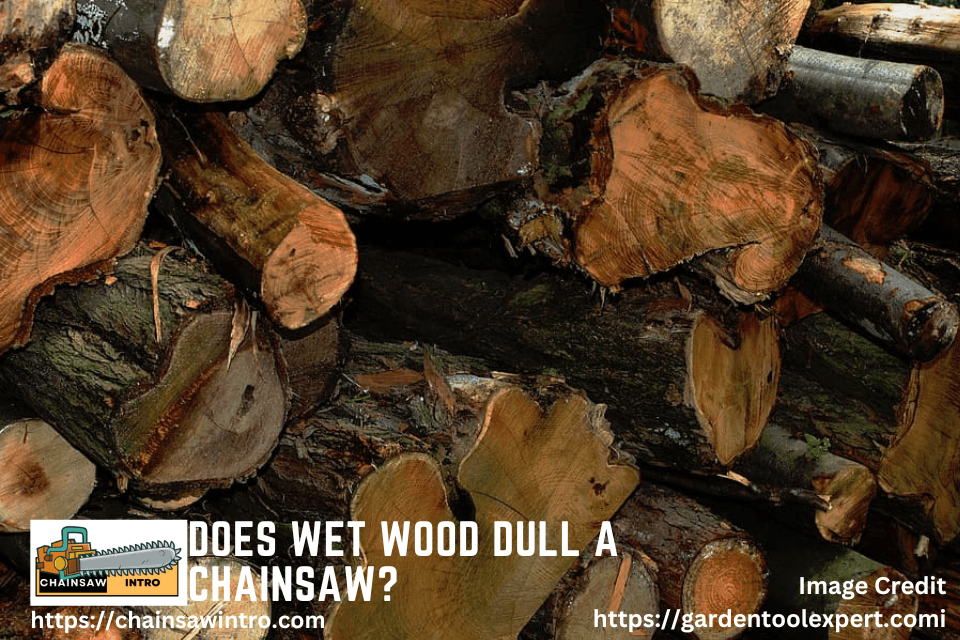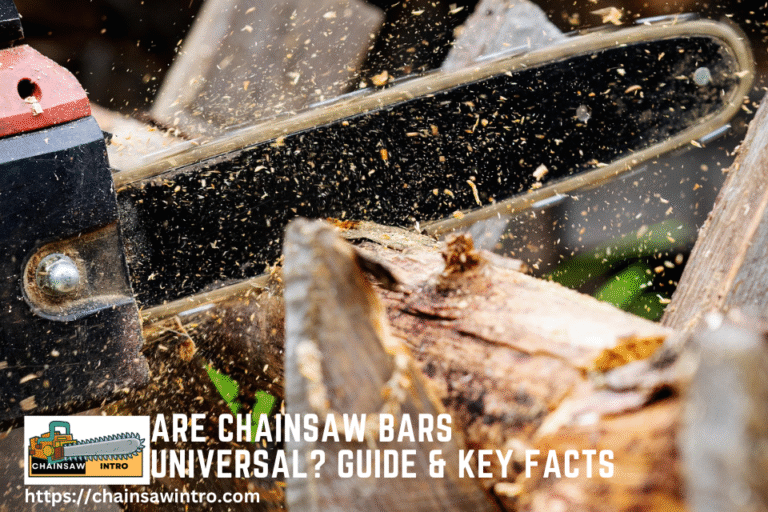When using a chainsaw, one common question that comes up is whether cutting wet wood can dull the chain faster. Homeowners, DIYers, and even professional loggers often encounter wood that is damp from rain, snow, or freshly cut green logs. Many wonder if moisture affects the sharpness and overall performance of the chainsaw. The truth is a bit more nuanced. Let’s break down the facts about cutting wet wood, chain durability, and how to keep your saw in peak condition.
How to Fix a Chainsaw That Burns Wood and Smokes
Does Wet Wood Actually Dull a Chainsaw?
The good news is wet wood itself does not dull a chainsaw chain any faster than dry wood. A chainsaw blade becomes dull primarily from hitting dirt, rocks, nails, or other hard materials embedded in the wood. Moisture in the wood does not wear down the cutting teeth.
However, wet wood can cause other issues:
- Sawdust from wet logs tends to clump and stick to the chain, bar, and sprocket.
- Excess moisture can make the chainsaw feel like it’s cutting slower, even though the chain isn’t actually dull.
- If not cleaned properly afterward, damp sawdust buildup can contribute to rust and faster wear on the bar and chain.
So while wet wood won’t blunt the teeth directly, it can make the chainsaw less efficient if not maintained.
How Wet Wood Impacts Chainsaw Performance?
While wet wood itself isn’t a major dulling factor, it affects chainsaw performance in other ways. The high moisture content creates stickier wood chips that adhere to the chain and bar, potentially clogging the bar groove and reducing oil flow. This can lead to increased friction, overheating, and slightly faster wear on the chain if not cleaned regularly. For example, cutting green softwoods like pine produces sappy residue, which compounds this issue, whereas hardwoods like oak may cut cleaner but demand more power due to density.
User experiences shared on forums highlight that cutting wet wood often feels “sluggish,” with chainsaws bogging down or requiring more effort to maintain speed. This is particularly true for battery-powered chainsaws, where wet wood can drain batteries 20-30% faster due to increased resistance. However, these effects are more about efficiency than direct dulling. The real threat comes when wet wood is dirty—common in storm-felled trees or logs stored on the ground—where embedded grit can dull a chain in as few as 5-10 cuts.
Green Wood vs. Wet Wood: What’s the Difference?
It’s important to separate wet wood from green wood.
- Wet wood refers to logs that have absorbed moisture from rain or snow.
- Green wood is freshly cut from a living tree and contains natural sap and moisture.
Green wood is harder to cut than seasoned firewood because of its fibrous texture and high sap content. Cutting green wood may feel tougher and cause more buildup on the chain, but again, it doesn’t necessarily dull the chain faster—it just makes cutting less efficient.
Factors That Actually Dull a Chainsaw
Instead of worrying about moisture, chainsaw users should pay attention to these main culprits of chain dulling:
- Dirt and Sand – Cutting logs that have been lying on the ground will dull the teeth faster than anything else.
- Metal Objects – Old nails, screws, or fencing inside a log can chip or ruin a chain instantly.
- Improper Cutting Technique – Pushing the chain into the wood too forcefully generates excess heat and wear.
- Lack of Lubrication – A dry chain rubbing against the bar overheats and loses sharpness.
- Overheating – Running the chainsaw at full throttle without breaks can burn out the edge.
Compared to these factors, wet wood is a minor issue.
Major Key Facts and Points About Wet Wood and Chainsaw Dulling
Here’s a concise summary of the critical points for quick reference:
- Wet Wood’s Direct Impact: Moisture itself doesn’t significantly dull chains; dirt and debris are the primary culprits.
- Indirect Effects: Wet wood’s sticky residue can clog chains, increase friction, and trap abrasive particles, indirectly accelerating wear.
- Performance Impact: Cutting wet wood may reduce efficiency, bogging down saws and draining batteries 20-30% faster.
- Primary Dulling Causes: Dirt, sand, metal, improper tension, and poor lubrication cause more damage than moisture alone.
- Maintenance Matters: Regular cleaning, proper oiling, and using semi-chisel chains mitigate wet wood’s challenges.
- Context is Key: Wet logs stored outdoors are more likely to carry dirt, increasing dulling risk compared to clean, green wood.
- User Insights: Arborists find wet wood easier to cut in some cases, but emphasize cleaning and maintenance to avoid issues.
How to Maintain Your Chainsaw When Cutting Wet Wood?
If you often cut wood in rainy or damp conditions, these maintenance tips will help extend the life of your chainsaw:
- Clean After Every Use – Remove the chain and bar, then brush off wet sawdust and debris.
- Dry the Chain – Wipe down the chain and apply a light oil coating to prevent rust.
- Sharpen Regularly – Use a chainsaw file to touch up the teeth after every few uses.
- Check Chain Tension – Moisture can cause wood fibers to bind; proper tension prevents kickback.
- Use High-Quality Bar Oil – Bar oil helps counteract the effects of wet sawdust and ensures smoother operation.
When Should You Sharpen Your Chainsaw Chain?
Whether cutting wet or dry wood, you should sharpen your chainsaw regularly. A good rule of thumb is:
- After every 2–3 hours of cutting.
- When you notice fine sawdust instead of chips.
- If the chainsaw pulls to one side or requires extra pressure to cut.
A sharp chain is far more important than whether the wood is wet or dry.
Conclusion | Cutting Wet Wood with Confidence
So, does wet wood dull a chainsaw? Not directly. Moisture in wood does not cause dulling, but it does lead to clogs, rust, and reduced efficiency if the saw isn’t cleaned afterward. What really dulls your chainsaw is dirt, rocks, and poor maintenance practices.
By keeping your chain sharp, cleaning your saw after use, and storing it properly, you can cut wet wood with confidence without worrying about damaging your chainsaw.
Frequently Asked Questions (FAQ)
Does wet wood dull a chainsaw faster than dry wood?
No, wet wood does not dull a chainsaw faster. What really dulls a chain is dirt, sand, nails, or hitting the ground while cutting. Moisture mainly causes clogging and sticky sawdust buildup.
Is it safe to cut wet wood with a chainsaw?
Yes, it’s safe to cut wet wood, but you should clean the chain and bar afterward to prevent rust and ensure smooth performance.
Does green wood dull a chainsaw?
Green wood doesn’t dull the chain directly, but because it’s fibrous and full of sap, it creates more resistance and buildup, which may require more frequent sharpening.
Can cutting wet wood damage a chainsaw?
Wet wood itself won’t damage a chainsaw, but trapped moisture and sticky sawdust can cause rust or clogging if the saw isn’t cleaned and oiled properly after use.
How do I keep my chainsaw sharp when cutting wet wood?
Regular maintenance is key—keep the chain sharpened, tensioned properly, and lubricated. Always clean and dry the saw after use to avoid rust.
Is it harder to cut frozen wet wood?
Yes, frozen wet wood is harder on the chain. Ice and frozen fibers create more resistance, which may lead to faster wear compared to unfrozen logs.
Is It Ok for a Chainsaw to Get Wet?
If you’re using your chainsaw in the rain, or even if it gets wet while you’re working with it, it’s perfectly fine. In fact, getting your chainsaw wet is actually good for it – as long as you take proper care of it afterwards. Water can cause corrosion on your chainsaw, so it’s important to dry it off and oil it after use.
If possible, store your chainsaw in a dry place when you’re not using it. If your chainsaw does get wet while you’re using it, be sure to clean and oil it as soon as possible afterwards.
Can You Use an Electric Chainsaw on Wet Wood?
Electric chainsaws are not recommended for use on wet wood. The moisture can cause the saw to malfunction and can also be a safety hazard. If you must cut wet wood, it is best to do so with a manual saw.
I’ve spent the past 10+ years working with chainsaws in forestry, landscaping, and firewood preparation. Along the way, I’ve gained certifications in chainsaw operation and safety and built extensive experience with trusted brands like Stihl, Husqvarna, and Oregon. I enjoy sharing my knowledge through step-by-step guides, tool reviews, and safety advice so others can get the most from their chainsaws while staying safe on every job.












